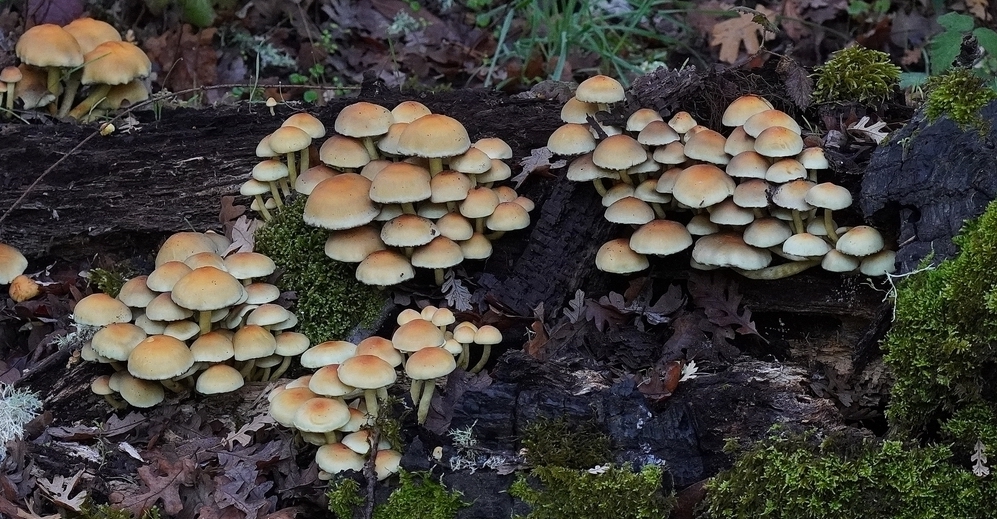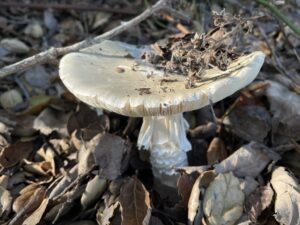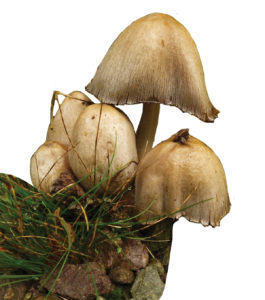From the whimsical to the macabre to the downright bizarre, there’s an incredible amount of diversity in the shape, size, color, and design of Bay Area fungi. According to the citizen science app iNaturalist, almost 1,700 species of fungi and lichens have been found in the greater Bay Area.
“The entire West Coast, from roughly San Luis Obispo or Monterey Bay up to Alaska abounds in fungal diversity because we have a combination of forests that go right down to the ocean and—well, we used to have—a very consistent rainfall regime,” says Trent Pearce, a naturalist with the East Bay Regional Park District.
This regional diversity, as well as the widespread understanding of the essential role fungi play in ecosystems, may explain why Bay Area nature-lovers seem to have a bit more affection for these often-maligned organisms. “The average American tends to be mycophobic, or afraid of wild mushrooms, and there’s a long history of that, going back to the Western European tradition in which the toadstool is sort of this vilified thing,” Pearce says.
But in the Bay Area, several annual festivals celebrate local fungi and bring together mushroom enthusiasts from around the region to swap tales of fungi-finding. One, the East Bay Regional Park District’s Tilden Fungus Fair, was founded five years ago by Pearce, who has organized and run it every year since. In 2021, due to COVID-19 restrictions, the Tilden Fungus Fair went virtual for the first time. So, instead of bringing specimens to show-and-tell, the park district organized a week-long mycoblitz around the Bay Area using the iNaturalist app.
In the course of one week in mid-January, 1,218 fungi-finders recorded 8,257 observations of 548 species. Those species showcase some of the unusual and fascinating features of the fungi that can be found in the Bay Area. “I like to think of them as the flowers of winter,” Pearce says. “They’re beautiful, they’re interesting, some of them are colorful, and you never know what you’re going to see fruiting.”
The most observed species, though, are probably not the most common species in the Bay Area. And that’s because unlike a scientific survey with random transects and data collection protocols, “iNaturalist is people going out hiking on their favorite trails and noticing things,” Pearce says. “On top of that is observer bias, where we see things that we’ve been conditioned to see or the things that we want to see.”
People may be more excited about documenting a big, bright mushroom rather than a small drab-looking one, and meanwhile they may not even notice a discreet one growing under a log. But for the same reasons, the top five most-observed mushrooms are perhaps the most eye-catching species that you have a decent chance of seeing while on a trail or at a park.
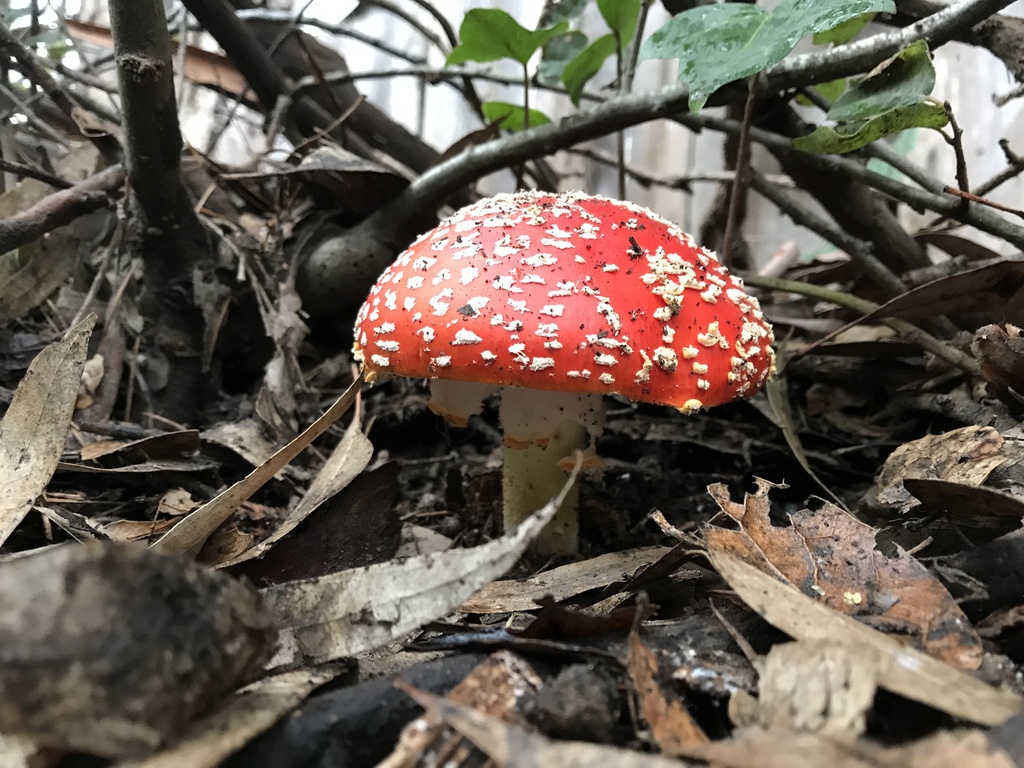
(Photo by Tiffany Theden via iNaturalist CC BY-NC 4.0)
The most-observed species from the January mycoblitz is probably the most familiar-looking mushroom you can find outside of a grocery store. It’s the emoji mushroom, the Super Mario mushroom, and a common feature of the Smurf village: the fly agaric (Amanita muscaria).
This mushroom bursts through leaf litter with a round cap covered almost entirely with pointy white or yellowish spots. The mushroom assumes its iconic fairytale appearance as it ages: the red cap expands and gradually flattens and the spots spread out. Some of the spots may fall off from heavy rain or disturbance, and if exposed to direct sunlight, the red cap can fade to orange.
The common name “fly agaric” comes from the mushroom’s use as a way to catch flies: apparently, if you put pieces of it in milk, flies will come for a sip, get intoxicated, and become unable to fly away. The neurotoxins have psychoactive effects on humans too, and the species is also considered highly toxic.
Some brave mushroom-eaters believe that Amanita muscaria can be cooked in a specific way that makes them edible, and some cultures in Siberia and elsewhere have consumed them. In a 2017 video op-ed in the New York Times, mycologist Laurence Millman even argues that a ritual of the Sami, the Indigenous people of modern day Finland, wherein a shaman eats the red and white mushroom, visits homes one by one on a reindeer-drawn sled, enters through the chimney rather than the snow-blocked doorway, and gives healing and wisdom in exchange for food offered by each household may have inspired some modern Christmas traditions.
Fly agaric is native throughout the temperate and boreal regions of the Northern Hemisphere, but today it can be found throughout the world. In the Bay Area, you can find it in urban parks as well as open space areas, often in the leaf litter of Monterey pine trees.
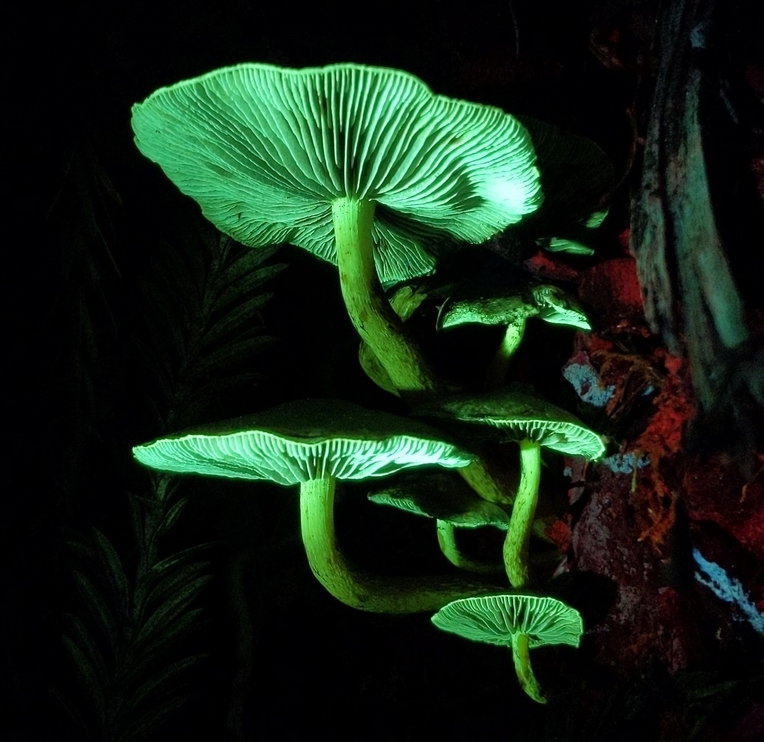
(Photo by Alan Rockefeller via iNaturalist CC BY-NC 4.0)
Though not nearly as well known as the Amanita muscaria, the sulphur tuft, or clustered woodlover, (Hypholoma fasciculare) is common in the Bay Area. It grows in large clusters of bright sulphur-yellow hued mushrooms, with darker pigment radiating from the center of the convex cap. The vibrancy later fades to an orange-ish tan color as the cap flattens.
The sulphur tuft also glows under a black light. Damon Tighe, a naturalist who presented at this year’s fungus fair, suggested that it might be the most UV fluorescent fungus species in the Bay Area. Shining a UV light on the sulphur tuft, you’ll see it reflect a bright green, which may be a feature the species developed to attract insects that help it spread its spores—although no one knows exactly why fungi fluoresce.
In fact, there’s a lot that Western science doesn’t know about fungi. “They’re wildly understudied,” Pearce says. “They’re these dirty little things that grow on the forest floor that are often overlooked by the general public and equally overlooked by both academia and academic funding.”
The sulphur tuft is saprobic, meaning that it plays the crucial role of nutrient recycling by breaking down detritus—in this case, rotting tree trunks and dead roots. As such, your best shot to see these may be in less manicured parks where dead matter is not removed, but allowed to decay naturally.
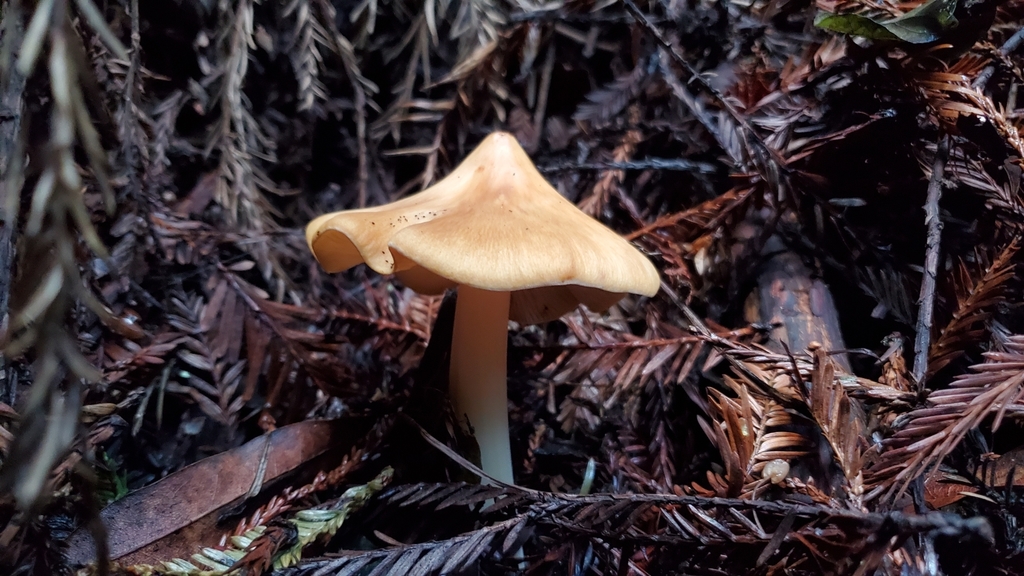
(Photo by James Morris via iNaturalist CC BY-NC 4.0)
The redwood rooter (Caulorhiza umbonata) has a delightfully literal name, which comes from its substrate, the acidic soil around coast redwoods, and its remarkably long stem that grows down through the redwood duff into the ground. Not only does this species grow only under coast redwoods, but it’s also one of the only medium to large fungi species found under these iconic trees.
The redwood rooter starts with a tawny brown cone-shaped cap that becomes more umbonate (umbrella-shaped with a rounded knob on top) over time. Eventually its edges curl upward to reveal the cream-colored gills underneath. The mushroom’s defining physical characteristic, however, is its stem. Although only a few inches stick out above ground, if you pull at its taproot-like stipe, you may find that it’s over a foot long.
Although foraging is not allowed in most public open spaces, including the East Bay Regional Parks and most state and national parks, picking a mushroom to examine its gills or stem will generally not damage the organism. “If the spore bearing surface is already exposed, that mushroom has already belched out thousands or tens of thousands of spores,” Pearce says. “The real hazard… lies with damaging the substrate in which the mushrooms are growing. Things like walking off trail, or repeated picking of the same area which causes trampling, can actually cause a loss of the duff layer on the soil and cause erosion and actually damage the mycelium.”

(Photo by Christian Schwartz via iNaturalist CC BY-NC 4.0. Schwartz, co-author of the popular field guide Mushrooms of the Redwood Coast, also gave a presentation on the fungi of the Santa Cruz Mountains at the 2021 Tilden Fungus Fair.)
The Western Jack-o-Lantern (Omphalotus olivascens) is another species that’s native to California, and it can only be reliably found in California and Mexico. It’s quite festive for Halloween, as its common name suggests, not just because of its orange color, but also because it glows in the dark. The western jack-o-lantern’s gills bioluminesce when they’re at the peak of spore production, when they’re middle aged. Unless you’re mushrooming at night, you may have to take one into a dark closet to see its blue-green glow.
Because of its shape, color, and clustering habit, the jack-o-lantern is sometimes confused with the edible chanterelle mushroom. But that’s a costly mistake, as western jack-o-lanterns are poisonous and can cause severe gastrointestinal issues. Distinguish these glowing mushrooms from their tasty doppelgangers by the olive undertone of their coloring or their substrate of hardwood (commonly oaks or Eucalyptus), whereas chanterelles grow in the soil around oaks.

(Photo by Katy Wang via iNaturalist CC BY-NC 4.0)
Rounding out the top five most-observed species from the Tilden Fungus Fair mycoblitz is the Yellow Fieldcap (Bolbitius titubans). Commonly found on dung and grass, this relatively small and fragile mushroom sticks out because of its bright egg yolk color.
The yellow field cap is brightest when it springs up, looking like a slimy yellow ball on a short hollow stem. As the cap opens into a convex shape, the color fades to a white or gray. Having quickly and efficiently dispersed its spores, the delicate mushroom then shrivels up. A particularly fleeting mushroom, the yellow field cap can erupt and disappear within 24 hours.
The ephemeral quality of many fungi species is another reason why these top five most-observed species may not reflect abundance. A casual observer only sees the species that are currently fruiting—that is, producing mushrooms in order to release spores and reproduce. A rigorous survey, on the other hand, might take soil samples to document the dozens or hundreds of species that exist throughout the year as mycelia under the surface. “If you want a bigger picture of the fungi on your favorite hiking trail, you really want to go out once a week, every week during the winter,” Pearce says.

(Photo on the left by John Dumbacher on January 1, 2021 in Baltimore Canyon Open Space Preserve near Mount Tamalpais, via iNaturalist, CC BY-NC 2.0; Photo by Lindsay Z on January 27, 2021 in Woodside, via iNaturalist, CC BY-NC 4.0)
Two other fun species, the turkey tail (Trametes versicolor) and the false turkey tail (Stereum hirsutum), also called hairy curtain crust, are also worth mentioning because they have the highest and second-highest number of observations ever on iNaturalist in the Bay Area. Pearce hypothesizes that they’ve racked up so many observations on the platform over time because they are perennial species that you can see year-round—although they do shrivel up a bit during the dry season.
Both can be found on tree trunks, stumps, and logs. And although they look similar, true turkey tail is a polypore, a leathery bracket fungus with pores on the underside of its conks, while false turkey tail is a crust fungus with a smooth underside. You can help experts provide accurate identifications on iNaturalist by taking photos of the top and the underside of a mushroom, as well as the substrate in which it’s growing, to help distinguish it from similar-looking species.
Explore
If you’ve never noticed the fungi you see on hikes or in open spaces, now may be the time to start. “Our climate is radically and rapidly changing, and that is having a very strong effect on our mushroom fruiting season,” Pearce says. According to Bay Area meteorologist Jan Null, the 30-year rainfall normals have dropped in all but one region of California over the past decade by an average of 5 percent.
“Last year, I didn’t see a Russula in Tilden until the middle of January, which from my limited experience—I’ve been a naturalist there for 10 years—that’s unheard of,” Pearce says. “…these species that previously used to come up in the fall aren’t coming up until January, and some of them not at all.”
iNaturalist is an excellent free resource for learning about fungi on your own. In the past several years, iNaturalist’s crowd-sourced platform has built up a healthy collection of fungi photos for thousands of species, which makes it easy to get to know nearby mushrooms. Your observations could also help improve the understanding of fungal adaptations to climate change, as well as fungal diversity in general. Plus, the application updates its data to reflect our ever-evolving understanding of mushroom genetics and taxonomy.

